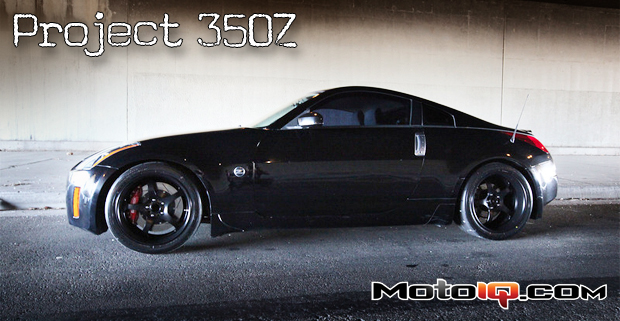,
 |
| The stock front differential bushing has big cutouts to allow a lot of movement. Good for smoothness but bad for wheel hop. |
The 350Z front suspension has a two-piece lower control arm with ball joints on the spindle and larger rubber bushings on the chassis side. These tend to get really pounded out on the stock car and Sera’s car was worse than most we see. The rubber bushings had sagged and the center hole was pushed well past the center of the bushing. This was probably allowing for quite a bit of toe change under load, we think things were probably moving around ½ in the lower arm alone.
 |
| These bushings are solid urethane by Whiteline. They firmly hold the nose of the diff which helps keep the pinion angle consistent. |
The Whiteline lower control arm bushings were really cool. They are solid in the middle but cut out on the edges so as to allow the lower control arm to articulate freely while keeping flex caused by lateral loading at bay. Most aftermarket urethane bushings we see are simply solid hunks of plastic, which can cause severe bind and stress on the suspension components in applications like this. Judging from the condition of the stock bushings we knew that the Whiteline lower control arm bushings were going to make a big difference here. Best of all Whiteline bushings have a lifetime warranty!
 |
| The rear bushing has these holes to allow some flex to absorb shock. There is a lot less free movement than stock. |
After stiffening up the bushings, we still wanted to get rid of more compliance and make the suspension fully adjustable. The 350Z’s suspension has limited adjustability. In the front, only the toe is adjustable and in the rear, the toe is adjustable and the camber is slightly adjustable. We needed full adjustability to get the most out of the tires. Although it is often ignored, getting the chassis alignment set up correctly makes just as big of a difference as any other part of the car's suspension!
 |
| The tired stock lower control arm bushings have big windows and soft rubber. This means a lot of moment which causes steering imprecision and poor control of the suspension geometry. |
In the front of our car, we needed more negative camber and caster than stock. Negative camber helps overcome the tire's deflection under load that tends to cause the tread to lift. Adding positive caster helps by having the negative camber increase as the wheels turn in. Positive caster also helps improve on center steering feel, straight-line stability and self-steering.
 |
| You can see how much the bushing has sagged here. |
 |
| These grooves in the bushing allows the bushing to articulate to reduce bind. The center of the bushing is solid to keep the control arm constrained in the direction that it is important to. Most urethane bushings are simply solid and bind putting stress on the suspension arms and even unpredictably affecting wheel rate. |
 |
| Howard uses a press to get the old bushings out and the new bushings in. |
 |
| The new bushings in place. From this picture you can see how it is important to have the bushings flex to allow the control arms to articulate yet the solid centers keep the arms from moving in undesired directions. |
Related










